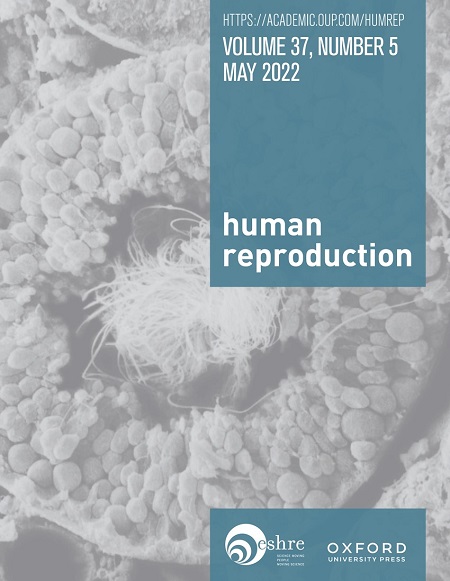An interpretable artificial intelligence approach to differentiate between blastocysts with similar or same morphological grades.
IF 6
1区 医学
Q1 OBSTETRICS & GYNECOLOGY
引用次数: 0
Abstract
STUDY QUESTION Can a quantitative method be developed to differentiate between blastocysts with similar or same inner cell mass (ICM) and trophectoderm (TE) grades, while also reflecting their potential for live birth? SUMMARY ANSWER We developed BlastScoringNet, an interpretable deep-learning model that quantifies blastocyst ICM and TE morphology with continuous scores, enabling finer differentiation between blastocysts with similar or same grades, with higher scores significantly correlating with higher live birth rates. WHAT IS KNOWN ALREADY While the Gardner grading system is widely used by embryologists worldwide, blastocysts having similar or same ICM and TE grades cause challenges for embryologists in decision-making. Furthermore, human assessment is subjective and inconsistent in predicting which blastocysts have higher potential to result in live birth. STUDY DESIGN, SIZE, DURATION The study design consists of three main steps. First, BlastScoringNet was developed using a grading dataset of 2760 blastocysts with majority-voted Gardner grades. Second, the model was applied to a live birth dataset of 15 228 blastocysts with known live birth outcomes to generate blastocyst scores. Finally, the correlation between these scores and live birth outcomes was assessed. The blastocysts were collected from patients who underwent IVF treatments between 2016 and 2018. For external application study, an additional grading dataset of 1455 blastocysts and a live birth dataset of 476 blastocysts were collected from patients who underwent IVF treatments between 2021 and 2023 at an external IVF institution. PARTICIPANTS/MATERIALS, SETTING, METHODS In this retrospective study, we developed BlastScoringNet, an interpretable deep-learning model which outputs expansion degree grade and continuous scores quantifying a blastocyst's ICM morphology and TE morphology, based on the Gardner grading system. The continuous ICM and TE scores were calculated by weighting each base grade's predicted probability and summing the predicted probabilities. To represent each blastocyst's overall potential for live birth, we combined the ICM and TE scores using their odds ratios (ORs) for live birth. We further assessed the correlation between live birth rates and the ICM score, TE score, and the OR-combined score (adjusted for expansion degree) by applying BlastScoringNet to blastocysts with known live birth outcomes. To test its generalizability, we also applied BlastScoringNet to an external IVF institution, accounting for variations in imaging conditions, live birth rates, and embryologists' experience levels. MAIN RESULTS AND THE ROLE OF CHANCE BlastScoringNet was developed using data from 2760 blastocysts with majority-voted grades for expansion degree, ICM, and TE. The model achieved mean area under the receiver operating characteristic curve values of 0.997 (SD 0.004) for expansion degree, 0.903 (SD 0.031) for ICM, and 0.943 (SD 0.040) for TE, based on predicted probabilities for each base grade. From these predicted probabilities, BlastScoringNet generated continuous ICM and TE scores, as well as expansion degree grades, for an additional 15 228 blastocysts with known live birth outcomes. Higher ICM and TE scores, along with their OR-combined scores, were significantly correlated with increased live birth rates (P < 0.0001). By fine-tuning, BlastScoringNet was applied to an external IVF institution, where higher OR-combined ICM and TE scores also significantly correlated with increased live birth rates (P = 0.00078), demonstrating consistent results across both institutions. LIMITATIONS, REASONS FOR CAUTION This study is limited by its retrospective nature. Further prospective randomized trials are required to confirm the clinical impact of BlastScoringNet in assisting embryologists in blastocyst selection. WIDER IMPLICATIONS OF THE FINDINGS BlastScoringNet provides an interpretable and quantitative method for evaluating blastocysts, aligned with the widely used Gardner grading system. Higher OR-combined ICM and TE scores, representing each blastocyst's overall potential for live birth, were significantly correlated with increased live birth rates. The model's demonstrated generalizability across two institutions further supports its clinical utility. These findings suggest that BlastScoringNet is a valuable tool for assisting embryologists in selecting blastocysts with the highest potential for live birth. The code and pre-trained models are publicly available to facilitate further research and widespread implementation. STUDY FUNDING/COMPETING INTEREST(S) This work was supported by the Vector Institute and the Temerty Faculty of Medicine at the University of Toronto, Toronto, Ontario, Canada, via a Clinical AI Integration Grant, and the Natural Science Foundation of Hunan Province of China (2023JJ30714). The authors declare no competing interests. TRIAL REGISTRATION NUMBER N/A.一种可解释的人工智能方法来区分具有相似或相同形态等级的囊胚。
研究问题能否开发出一种定量方法来区分具有相似或相同内细胞团(ICM)和滋养层(TE)等级的囊胚,同时还能反映它们的活产潜力?我们开发了 BlastScoringNet,这是一种可解释的深度学习模型,它以连续的分数量化囊胚的内细胞团和滋养层形态,能够更精细地区分相似或相同等级的囊胚,分数越高,活产率越高。此外,在预测哪些囊胚更有可能导致活产方面,人类的评估是主观的,也是不一致的。首先,使用一个包含 2760 个囊胚的分级数据集开发 BlastScoringNet,该数据集包含多数人投票选出的 Gardner 等级。其次,将该模型应用于已知活产结果的 15 228 个囊胚数据集,以生成囊胚评分。最后,评估这些分数与活产结果之间的相关性。这些囊胚收集自 2016 年至 2018 年期间接受试管婴儿治疗的患者。为了进行外部应用研究,还从 2021 年至 2023 年期间在外部试管婴儿机构接受试管婴儿治疗的患者中收集了 1455 个囊胚的额外分级数据集和 476 个囊胚的活产数据集。参与者/材料、设置、方法在这项回顾性研究中,我们开发了 BlastScoringNet,这是一个可解释的深度学习模型,可根据加德纳分级系统输出膨胀度等级和连续分数,量化囊胚的 ICM 形态和 TE 形态。连续的 ICM 和 TE 分数是通过对每个基础等级的预测概率加权并将预测概率相加计算得出的。为了表示每个囊胚活产的总体可能性,我们使用其活产几率比 (OR) 综合了 ICM 和 TE 分数。通过将 BlastScoringNet 应用于已知活产结果的囊胚,我们进一步评估了活产率与 ICM 分数、TE 分数和 OR 合并分数(根据扩张程度调整)之间的相关性。为了测试其通用性,我们还将 BlastScoringNet 应用于一家外部试管婴儿机构,并考虑了成像条件、活产率和胚胎学家经验水平的差异。主要结果和机会的作用BlastScoringNet 是使用 2760 个囊胚的数据开发的,囊胚的膨大度、ICM 和 TE 得分均由多数人投票决定。根据每个基础等级的预测概率,该模型的接收者操作特征曲线下的平均值分别为:膨胀度 0.997(SD 0.004),ICM 0.903(SD 0.031),TE 0.943(SD 0.040)。根据这些预测概率,BlastScoringNet 为另外 15 228 个已知活产结果的囊胚生成了连续的 ICM 和 TE 分数以及膨胀度等级。较高的 ICM 和 TE 分数以及它们的 OR 合并分数与活产率的增加显著相关(P < 0.0001)。通过微调,BlastScoringNet 被应用于一家外部试管婴儿机构,在该机构中,较高的 ICM 和 TE OR 组合评分也与活产率的增加显著相关(P = 0.00078),这表明两家机构的结果一致。BlastScoringNet 为评估囊胚提供了一种可解释的定量方法,与广泛使用的加德纳分级系统相一致。较高的 OR 合并 ICM 和 TE 分数代表了每个囊胚活产的整体潜力,与活产率的提高有显著相关性。该模型在两个机构中的通用性进一步证明了其临床实用性。这些研究结果表明,BlastScoringNet 是协助胚胎学家选择活产可能性最高的囊胚的重要工具。代码和预训练模型均可公开获取,以促进进一步研究和广泛实施。这项工作得到了加拿大安大略省多伦多市多伦多大学向量研究所和特默蒂医学院的临床人工智能集成资助,以及中国湖南省自然科学基金(2023JJ30714)的支持。作者声明不存在利益冲突。
本文章由计算机程序翻译,如有差异,请以英文原文为准。
求助全文
约1分钟内获得全文
求助全文
来源期刊

Human reproduction
医学-妇产科学
CiteScore
10.90
自引率
6.60%
发文量
1369
审稿时长
1 months
期刊介绍:
Human Reproduction features full-length, peer-reviewed papers reporting original research, concise clinical case reports, as well as opinions and debates on topical issues.
Papers published cover the clinical science and medical aspects of reproductive physiology, pathology and endocrinology; including andrology, gonad function, gametogenesis, fertilization, embryo development, implantation, early pregnancy, genetics, genetic diagnosis, oncology, infectious disease, surgery, contraception, infertility treatment, psychology, ethics and social issues.
 求助内容:
求助内容: 应助结果提醒方式:
应助结果提醒方式:


